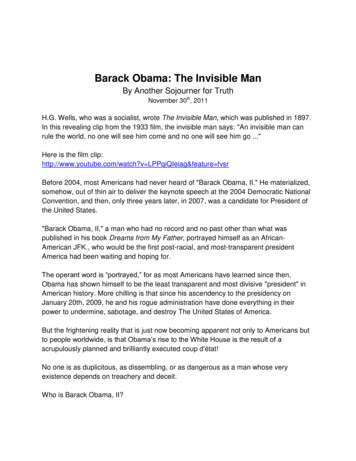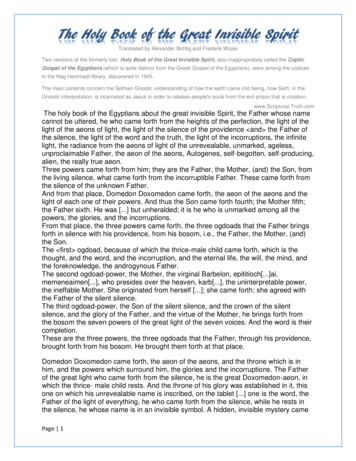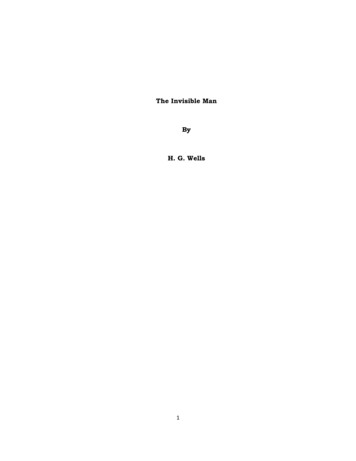
Transcription
International Journal of Role-Playing - Issue 1The Invisible Rules of Role-PlayingThe Social Framework ofRole-Playing ProcessPopular Abstract - This paper looks at the process of role-playing that takes place in various games.Role-play is a social activity, where three elements are always present: An imaginary game world, apower structure and personified player characters. In a nutshell, all role-playing activities aboutimaginary people acting out in an imaginary environment; the power structure is needed todifferentiate these activities from free make-believe and children’s play. After the basics, the papermoves on to discuss the various components in detail, going through how rules, goals, worlds, power,information and identity function in role-play. While the paper does not lead to a simple conclusion, itseeks to present a solid foundation for further research.Markus MontolaUniversity of TampereFinlandmarkus.motola@uta.fiABSTRACTThis paper presents a structural framework forrole-playing that can be used as a foundation whencreating further role-playing theory. Theframework is based on assumption that all gamesare based on rules, and tries to make the implicitrules of role-playing visible by proposing the threerules of role-playing. Compared to regular gaming,role-playing is seen ultimately as a qualitativeprocess rather than a quantitative one,differentiating it from many regular games.1. INTRODUCTION¹When studying games, a critical differentiation hasto be made separating the study of games as formalsystems from study of games as social processes. Inthe formal system of Texas hold’em Poker theplayer has quite limited number of legal optionsinfluencing her chance of winning a single round –in addition to bidding, she may change some cardsor fold right away.In the social process of gameplay the alternativesare a much wider. Gamers might influence eachother in a million ways beginning from bluffingand threatening, with or without the intent ofaffecting the outcome of the game. Clearly, lookingat Poker as a formal system can never fully graspthe whole essence of the game – the game as it isplayed is very different from the game on paper.Role-playing has also been often defined as a gamesystem (e.g. Mackay 2001), though some attemptsto look at it as a gaming process (e.g. Hakkarainen& Stenros 2002) have been done as well. Based onHeliö (2004), it can be argued that any formal gamesystem can be used as a basis of role-playingprocess, provided the players have the propermindset, and that any formal game system is notnecessarily needed. On the other hand it has beennoted that any role-playing game – whether we arediscussing traditional tabletop role-playing games,larps (live role-playing games) or online roleplaying games – can be participated without roleplaying. Bartle (2004) for instance decides thatonline worlds are not games but places, since theylack many qualities of games while having severalqualities of places.Partially due to this confusion, the ludologicaldiscussion has been confused on whether roleplaying is game playing or not. Typically, theanalyses have focused on the role-playing games asrulesets. Role-play has been seen as a borderlinecase of game for various reasons. Due to gamemaster’s influence, role-playing lacks static rules(Juul 2003), and many role-playing systems do notallow the players to rate their characters’ success or¹ This paper was originally written in 2005 and updated in 2008. My two other papers (Montola 2007a, 2007b) alreadyreference it.22
International Journal of Role-Playing - Issue 1failure in the game as “positive” or “negative”thing (Montola 2005).In this paper I see role-playing mindset as amethod of game playing, which can be optionallycombined with various game systems. It is not theonly distinct gaming mindset. For instance, somegames are supposed to be played with mindset of aconspiratorial diplomacy and backstabbing, whileothers require a honorable sportsmanship or a styleprioritizing style over success.Hakkarainen and Stenros (2002) define roleplaying game as that which “is created in theinteraction between players or between player(s)and game master(s) within a specified diegeticframework”. This definition approaches roleplaying from the angle of communication. If roleplaying games are to be studied as games, a moreludological definition is required, one thatdemonstrates the similar game-like and features ofall different forms of role-playing. It must also beunderstood that Bartle’s notion of persistentworlds being places rather than games isappropriate to all forms of role-playing to certainextent.To this end, we need to make the implicit rules ofrole-playing visible. Typically the role-playingcontexts such as virtual worlds, tabletop gamerulesets and larp events only provide algorithmicrules of the formal system used as a platform forrole-playing, but do not explicate the rules of roleplaying expression itself. In this paper, I look at theplayed game as a game, not the game presented inthe tabletop role-playing game rulebooks.The following discussion includes several forms ofrole-playing, focusing on tabletop role-playing,live-action role-playing and virtual role-playing(see Montola 2003).² Other forms do exist,including freeform role-playing (which combineselements from larp and tabletop role-play) andpervasive role-playing (Montola 2007b), and evenmore can be invented. Additionally, there is agroup of borderline forms of expression andgaming that might constitute role-playing asdefined in this paper. These include a forms such asimprov, psychodrama and Happenings.³2. The Invisible RulesBjörk and Holopainen (2003) divide game rulesand game goals into endogenous and exogenouscategories – the rules and goals defined in thegame structure, and the rules and goals brought tothe game activity by players to give it meaning.Earlier, Fine (1983) has proposed a three-layered⁴structure for role-playing, consisting of a primary(social) frame inhabited by people, secondary(game) frame inhabited by players and tertiary(diegetic) frame inhabited by characters.Combining the approach of Fine with that of Björkand Holopainen, it is clear that endogenous rulesare a part of the game frame, while exogenousrules are a part of the social frame. However, weneed to add a third category, that of diegetic rulesand diegetic goals, for rules and goals existingwithin the fiction of the role-play (see Montola2005).Illustrating Fine’s three frames with examples, thisis how they look like: “Do not discuss non-game business duringthe game” – exogenous. “A sword does d10 points of damage” –endogenous. “Carrying a sword within the city limits ispunishable by fine” – diegetic.In its various forms, role-playing process appearsto follow certain endogenous yet implicit rules,making it simultaneously a relatively formal wayof expression and a relatively informal kind of agame. These rules have not been explained as rulesin the published role-playing games, but rather thisimplicit information has been conveyed in thesections of the book trying to explain what roleplaying is or how a role-play should be conducted.For all role-playing in general I propose thefollowing three rules, which are the world rule, thepower rule and the character rule:1) Role-playing is an interactive process ofdefining and re-defining the state, propertiesand contents of an imaginary game world.2) The power to define the game world isallocated to participants of the game. Theparticipants recognize the existence of thispower hierarchy.² Tabletop role-playing is also sometimes called pen ‘n’ paper role-playing. Live-action role-playing is called oftenlarping, and virtual role-playing includes role-playing in persistent on-line worlds such as MUDs and MMORPGs.³ See e.g. Kaprow 1966 and Boal 2002 for direct sources, and Morton 2007 and Harviainen 2008 for role-play approaches.⁴ Mackay (2001) has proposed a five-layered version, dividing the diegetic framework into three layers depending on thestyle of parole used in them. Kellomäki (2004) has a model similar to Mackay’s with four layers of interaction: social,game, narration and characters.23
International Journal of Role-Playing - Issue 13) Player-participants define the game worldthrough personified character constructs,conforming to the state, properties andcontents of the game world.Depending on the platform and methodologyused, the possible participant roles include player,game master, actor, live musician, systemadministrator et cetera. The player role is a specialcase among these, since presence of a participant ina player role is a logical requirement for a “game”.Role-playing as defined in this paper is notpossible without any players with personifiedcharacters; this distinction is made in order toseparate role-playing from various forms ofcollaborative storytelling.The rules 1, 2 and 3 also define role-playing: Allgaming conducted according to them is roleplaying, while the gaming not based on them isnot. Thus, it can be said that role-playing is a gameof formal make-believe. Though the game world isfluid and and undergoing a constant re-definitionprocess, the re-definitions are restricted by thecurrent state of the game world; thus, the processof constant iteration does not allow completelyarbitrary or random changes (see also Kellomäki2004). This iterative nature is necessary for theludic, gamelike experiences created in role-playing,since it moves the focus from creating fictionexternally to acting within it. The existing fictionprovides the constraints and opportunities makingthe experience meaningful as a game. The gamemaster and the character are structures that areused to establish the limits of definitional power inthe game. As restrictions of rules give meaning toordinary gameplay, in role-playing the restrictionsof defining power give meaning to acting withinthe game world. These restrictions alsodifferentiate role-play from make-believe.I also present four optional, additional rules thatoften complement the first three rules. These arenot definitional criteria of role-playing, but they areused so commonly that their descriptive valuewarrants the inclusion here. The possibilities ofadditional rules are endless, but these are probablythe most typical and descriptive of them.i) Typically the decisive power to define thedecisions made by a free-willed characterconstruct is given to the player of thecharacter.ii) The decisive defining power that is notrestricted by character constructs is oftengiven to people participating in game masterroles.iii) The defining process is often governed by aquantitative game ruleset.iv) The information regarding the state of thegame world is often disseminatedhierarchically, in a fashion correspondingwith the power structure of the game.There are infinite ways of dividing the power todefine in role-playing games. The ways of doingthe division begin from the dictatorial andomnipotent game master, ending in a completelycollective system lacking any ultimate authority(see Svanevik 2005). These divisions are sometimeschanged during the game, for instance the gamemaster role might move from participant toanother, or some participant might be given thedecisive defining power within certain areas orevents of the game. Player-participants are alsooften given more power than declared in rule three.Additionally, these three endogenous rules (basedon Loponen & Montola 2004, Montola 2003)differentiate certain forms of role-playing fromeach other:t1) In tabletop role-playing the game world isdefined predominantly in verbalcommunication.l1) In larp the game is superimposed onphysical world, which is used as afoundation in defining the game world.v1) In virtual role-playing the game issuperimposed on a computational virtualreality, which is used as a foundation indefining the game world.By this definition, role-playing conducted ininternet chats, for instance IRC-roleplaying, isusually not virtual role-playing but a form closer totabletop role-playing. If the chat is a part of a larpstaged in physical world, chatting is part oflarping, and if it is a part of virtual world, it is partof virtual role-playing. Virtual role-playingrequires a computerized virtual representation ofreality (typically textual or graphical): It should benoted that due to this, all virtual role-playinggames are governed by a quantitative ruleset (iii) tosome extent, since all virtual worlds aremathematical rule systems.While rules 1, 2 and 3 defined role-playing, rules iiv provide typical, descriptive additions to the firstthree rules. However, the latter rules are notpowerful in defining role-playing. Rules t1, l1 andv1 can be combined with rules 1, 2 and 3 in orderto define certain subforms of role-playing, so theyare also definintive in nature.24
International Journal of Role-Playing - Issue 1Though game rules are often seen as mathematical,logical or algorithmic systems, the structures of agame can actually be classified into quantitativeand qualitative structures, depending on whetherthey can be reduced into numbers and or not. Insports striving for aesthetic value – such as skijumping and ice dancing – the qualitative activitiesare quantified by referee boards who transform thequalitative part of the performance into points.The rules of role-playing (1, 2, 3) are obviouslyqualitative and non-algorithmic. In this sense roleplaying differs from the majority of games.Sometimes, especially in tabletop role-playing, thegame master acts as the quantifying entity, byevaluating characters’ actions and determining thedice rolls the players must make in order to havetheir characters succeed. Character discussions andnon-contested actions usually are handled withinthe qualitative system, while all-out combat is oftenvery quantitative, especially within the rulesoriented tabletop role-playing cultures. Roleplaying does not need the quantitative part towork, but performing qualitative actions isnecessary for the process of game world definition.There are infinite ways of dividingthe power to define in role-playinggames. The ways of doing the divisionbegin from the dictatorial andomnipotent game master, ending in acompletely collective systemlacking any ultimate authority.Salen and Zimmerman (2004) differentiate thegame rules into three categories: operational rules,constituative rules and implicit rules. Operationalrules tell the players how the game is supposed tobe played, while the constituative rules define thelogical and mathematical system underlying theoperational rules. Implicit rules are the unwrittensocial rules governing the play. Just like the socialgaming important to a Poker process, the rules ofrole-playing pose a problem to Salen andZimmerman’s classification system, beingconstituative but qualitative, and implicit but stillsomehow operational.⁵ Using the division of Björkand Holopainen (2003) above, the rulesets used as abasis for role-playing are endogenous rules, as arethese rules of role-playing process.3. Role-Playing and GoalsA layered structure similar to the rules exists forgoals as well.⁶ However, role-play typically has noinherent endogenous goals at all. The rules of roleplaying only provide the structure for the activity,but give no end condition or an objective. Classicaltabletop role-playing rulesets and virtual worldssometimes implicitly offer some pursuits forplayers to follow, usually involving characterpower development or survival. These are rarelytrue endogenous goals either: as no one can win orlose in role-playing, the emphasis of the action isnot even focused on the game frame.The most central goals that provide role-play withcontent are defined and accepted within thediegetic frame, by players defining the world andcharacters. This distinction is one of the key issuesin the discussion whether role-playing gamesshould be defined as games or not. “I want to have fun in this game” –exogenous. “I want to explore Norwegian refugeepolitics in this game” – exogenous. “I want to become the mightiest wizard inthe kingdom” – diegetic. “I want to play the man tragically failing inhis quest of becoming the mightiest wizardin the kingdom” – exogenous.The contradiction of the goals in different frames isa common gratifying element in role-playing. Justas a spectator enjoys a tragical experience broughtto her by actors on the stage, a role-player enjoyscreating one for herself.The endogenous goals made explicit in the writtensystem of a role-playing game only become ameaningful part of the role-playing process, if theplayers interpret them into the game world asdiegetic goals. The most traditional role-playinggames intentionally leave the endogenous goalsundefined or vague, and even when they areexplicated clearly, player troupes often disregardthem entirely.In some exceptional role-playing games there areexplicit endogenous goals that are critical for thegame as a whole. Examples of these include many“Forge-style” games such as My Life with Master(Czege 2003) and Circle of Death style larps (Tan2001) such as Killer (Jackson 1981). While My Lifewith Master is intended to follow a certain story arc⁵ The tacit knowledge of how to play Poker is not communicated in the written game rules, but the players stillcommunicate that social maneuvering is a legitimate and important part of the play.⁶ I have discussed the role-playing goals in deeper detail in Montola (2005), in the particular context of role-playingwithin virtual worlds.25
International Journal of Role-Playing - Issue 1practically every time it is played, ending up in thedeath of the master in the hands of his minions,Killer is a very gamist assassination game whereplayers really try to win the game.⁷ My Life withMaster and Killer feature endogenous goals such asthe following: “When minion’s love for the villagers hasgrown strong enough, slaying the masterbecomes her goal” – endogenous. “The player whose character kills the mostenemy characters is the winner” –endogenous.As I have discussed earlier (Montola 2005), theendogenous goals dominate the contemporaryonline role-playing game design culture. The roleplaying players occasionally translate theendogenous goals into diegetic goals. Thefollowing example is from (the original version of)Star Wars Galaxies. “By completing the jedi quests and collectingenough experience points, the characterbecomes a jedi” – endogenous.The value of the endogenous goals is derived fromthe players’ exogenous goals. If a role-player’s aimis to have a good role-playing experience, such anendogenous goal is only valuable if she cantranslate it into a diegetic goal as well. If it cannot,it might just be ignored.The goals of the social level vary immensely fromone gaming culture to another; sometimes theexplicit dissonance of social and diegetic goals is asource of enjoyment, while often diegetic charactersuccess is teamed with social pursuit of success inthe game. As role-playing does not take place inthe domain of ordinary life, tragic experiences canbe highly pleasurable.The exogenous goals are not restricted toentertainment – the normative claim of fun beingthe only purpose of role-play (e.g. Laws 2002,Duguid 1995) is simply erroneous. In a moreconstructive approach, Mäkelä & al. (2005) proposea list of six gratifications that warrant furtherstudy: entertainment, learning, meaning, aestheticappreciation and social and physical benefits.4. THE ELUSIVE GAME WORLDRyan (2001, 91) sums up the concept of world withfour features, defining it as a connected set ofobjects and individuals, a habitable environment, areasonably intelligible totality for externalobservers and a field of activity for its members. Inrole-playing the world construction can be seen asa textual⁸ process, where different actors produceelements that are in the process combined into newtexts (Aarseth 1997, Kellomäki 2004).The earlier discussion on the game world of roleplaying games has discussed it both with acollective (Hakkarainen & Stenros 2002, Pohjola1999, Heliö 2004) and a subjective (Montola 2003,Andreasen 2003, Loponen & Montola 2004)emphasis. In this paper, I call the collectivestructure a “game world”, as it is ludologicallyproper term to describe the arena where the gameis played, while the subjective structure is“diegesis”, a subjective view created byinterpreting input from the other participants andenvironment, complemented by the participant’sown creative additions.⁹Player perceptions on the game world areconstructed in interpersonal textual interaction. AsRyan (2001) explains, cultural background andJust as a spectator enjoys a tragicalexperience brought to her by actorson the stage, a role-player enjoyscreating one for herself.imagination are used in building a world based ontextual inputs.“The idea of textual world presupposes thatthe reader constructs in imagination a set oflanguage-independent objects, using as aguide to the textual declarations, butbuilding this always incomplete image into amore vivid representation through theimport of information provided byinternalized cultural knowledge, includingknowledge derived from other texts.”As I have discussed earlier (Montola 2003,Loponen & Montola 2004) the problems inherent tocommunication mean that every player has a⁷ There are many curious similarities between Killer and My Life with Master, despite the fact that Killer can beconsidered extremely gamist role-playing game while My Life with Master is an explicitly narrativist one. (See Kim 1998for discussion on gamism, narrativism and simulationism).⁸ Even though Aarseth (1997) differentiates cybertexts from hypertexts by requiring cybertexts to have a computationalelement in their creation, he still brings up role-playing activities as “oral cybertexts”.⁹ What I call game world has also been called a shared imaginary space (SIS). According to Mäkelä & al. (2005) theimagined spaces (IS) of the participants overlap to create the shared imaginary space; Hence, their imaginary26
International Journal of Role-Playing - Issue 1different reading of the game world provided byother players. In addition to the reading of thegame world, every player complements herperception of the game world by never-expressedinternal ideas and feelings. This internal elementcombined with the reading constitutes participant’ssubjective diegesis, which is the end result createdby the player in the process of playing: Thesubjective diegesis is both the primary productcreated in the role-play and the transient object ofaesthetic value.¹⁰ No participant of the process canever understand the game world completely, asparts of it are unaccessible – created by otherplayers but never voiced aloud.The interactive process¹¹ of arbitration producingthe diegeses and the game world is usually basedon negotiation and cooperation rather than onstruggle or contest. Usually this arbitration processis implicit, but explicit negotiation is used toreconcile radical differences in player diegeses.Perhaps counter-intuitively, the imaginary andarbitrary nature of the game world is the forceguiding the players to cooperate in diegesisThe exogenous goals are notrestricted to entertainment– the normative claim of fun beingthe only purpose of role-playis simply erroneous.construction. Though conflict is often simulated inthe game frame, it stems from the diegetic frame.Game master¹² and game mechanics are the twocentral methods created specifically in order toavoid the struggle on the level of form, in order tokeep it on the level of game content. Typically theconflict begins from the game world, potentiallyescalating to game frame and occasionally even tothe social frame. This happens if the players firstneed rules to solve the conflict between characters,and then if the players begin to argue over therules as the conflict escalates.If game world construction is looked as acommunication system, it can be seen as aninterpretation loop of three basic activities:1. Interpreting outside input into the subjectivediegesis2. Making changes into the diegesis3. Communicating the changes to otherparticipantsThis cycle of three activities is a theoretical model;in practice all these functions are performedsimultaneously. In larp, for instance, playerwalking on a street constantly changes the diegesis(by moving herself), while getting new input(seeing new things) and communicating the changeto other players (who see her moving. In tabletoprole-playing this decision-making model appearsmore clearly, elaborating the continuous cycle ofiterative reinterpretation of the world in thecommunication loop of the game.To keep up the loop of interpretation the playersmust be able to understand the world they aredefining and re-defining. They have to understandthe diegetic laws of nature and the state of thediegetic world in order to uphold the logic of thegame world, constructing its future based on itsproperties, state and history. In order for the gameworld to work as a place or a space, the worldneeds not to be “realistic” but sensible; the laws ofnature can be very different to ours.¹³ In Juul’s(2003, 117) classification of game worlds this meansthat the game world has to be coherent – whichmeans that there must be nothing that wouldprevent a person from imagining the world in anydetail. Only extremely experimental games can bespace is equivalent to my diegesis. The idea of a shared imaginary space contains an oxymoron, as no imaginary thingcan ever be truly shared.¹⁰ Sandberg (2004) discusses the idea of a “first-person audience”, with the idea that only the role-player can properlyunderstand and appreciate her own subjective creation.¹¹ My use of term “interaction” denotes that A can affect B’s way of affecting A in a non-predetermined and non-trivialfashion, and vice versa (as opposed to Costikyan’s (2002) trivial definition). Indeed, this decision excludes the singleplayer computer games: This paper discusses role-playing as a social process, requiring two sentient participants.¹² Game master’s role originated from the role of a wargame referee. In wargames, the struggle is supposed to take placebetween gamers on the game level, not between people fighting over rules on the social level – including a refereefacilitated this process.¹³ An innovative example of ruleset portraying the genre of the diegetic world as well as its laws of nature is Amber:Diceless Role-Playing. The author Erick Wujcik (2004) emphasized that the game is not diceless due to “some obscuretheoretical reason”, but rather to capture the feel of Roger Zelazny’s Amber books. “In the original books nothing everhappens by chance; every time something seems to happen by chance, it is revealed that someone was manipulating theevents behind the scenes. In Amber the theme should be the same, hence dice are not needed”. In many cases such asthis, the game world physics are mixed with genre elements: reading the rules it is impossible to tell how mechanics ofprobability work within the world of Amber.27
International Journal of Role-Playing - Issue 1made in abstract, iconic or incoherent worlds. It isdifficult or even impossible to role-play in worldssuch as the ones portrayed in Super Mario Bros orChess.¹⁴information in a coherent world (Juul 2003, 111).Distinction is certainly theoretical especiallyregarding larps, since the physical world is alwaysinfinitely detailed anyway.It would be a simplification to say that the use ofan artefact (such as a virtual space or physicalreality) as the basis of game world would restrictthe use of player imagination, though the artifactprovides fairly strong initial definitions for manydiegetic elements. However, as I argue that roleplaying is a process of social interaction takingplace in an imaginary game world, it should beemphasized that in role-playing process elementsexplicit in the artifact are often re-defined whenthey are interpreted into players’ diegeses. As Ryan(2001) puts it, the children playing make-believeselect an actual object x₁ and agree it represents avirtual object x₂. Then the players imaginethemselves as members of the world in which x₂ isactual. An action is legal when the behavior itentails is appropriate for the class of objectsrepresented by x₂. A legal action generates afictional truth.McCloud (1993) discusses the way sequentialimages of comics are understood though theprocess of closure. While a comic book is composedout of still, juxtaposed images, the reader fills in thelacking elements in the process of reading, creatingthe impressions of time and movement, also fillingin elements not shown in the images. A smiley isclosed into a smiling face in a fashion similar to theway a spectator watching a movie closes the roomwhere the characters are discussing. The movieimage is not closed with impressions ofcameramen and studio equipment, but with wallsand landscapes extrapolated from the ones shownon screen.¹⁵ Even without any visual evidence, aspectator uses her earlier experience to assume thatthe news anchor has two legs, even though theyare not shown on the screen.This re-definition happens in an arbitration processgoverned by the possible rules and instructions ofthe game, and is based on the divisions of definingpower used in the game. In larp, the player doesnot need to physically fly in order for his characterto do so. By comparison, neither needs the virtualavatar to fly in virtual world for the role-playedcharacter represented by the avatar to do so.In role-playing, a semi-conscious closing process iscrucial, as players are constantly dealing with anincomplete representation of the game world. Inthe first phase of the interpretation loop, theplayers make assumptions on the world,extrapolating and interpolating their diegesesbased on the explicit game discourse.These re-definition practices are also cultural.Many role-player communities in virtual worldshabitually pretend to use and handle plot-
discussion has been confused on whether role-playing is game playing or not. Typically, the analyses have focused on the role-playing games as rulesets. Role-play has been seen as a borderline case of game for various reasons. Due to game master's influence, role-playing lacks static rules (Juul 2003), and many role-playing systems do not










